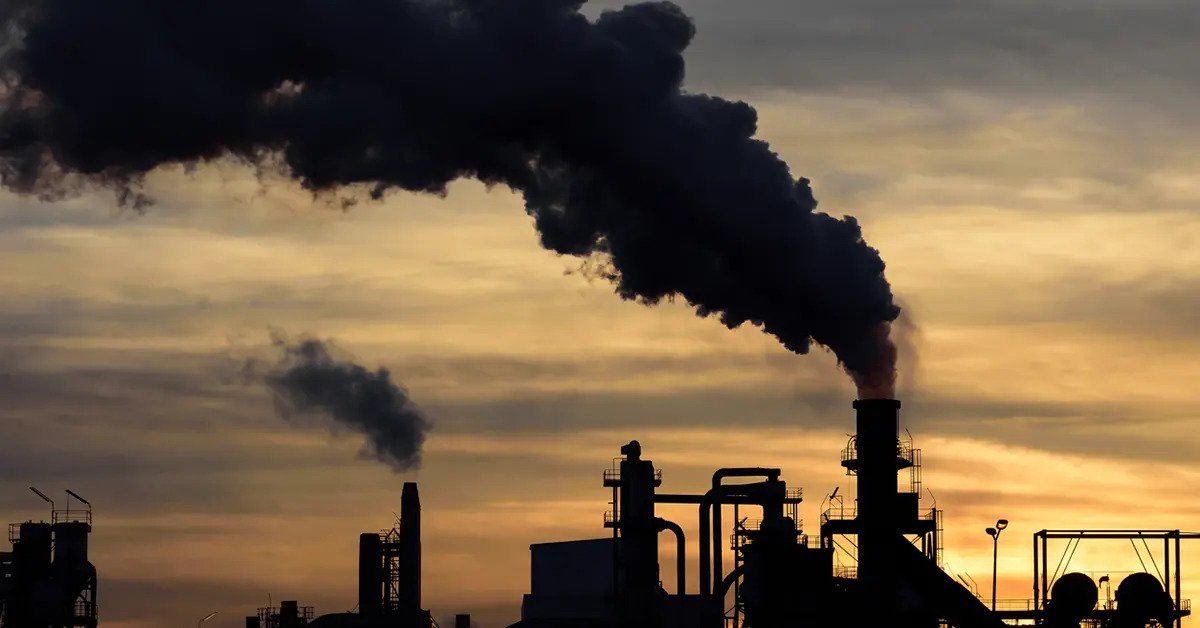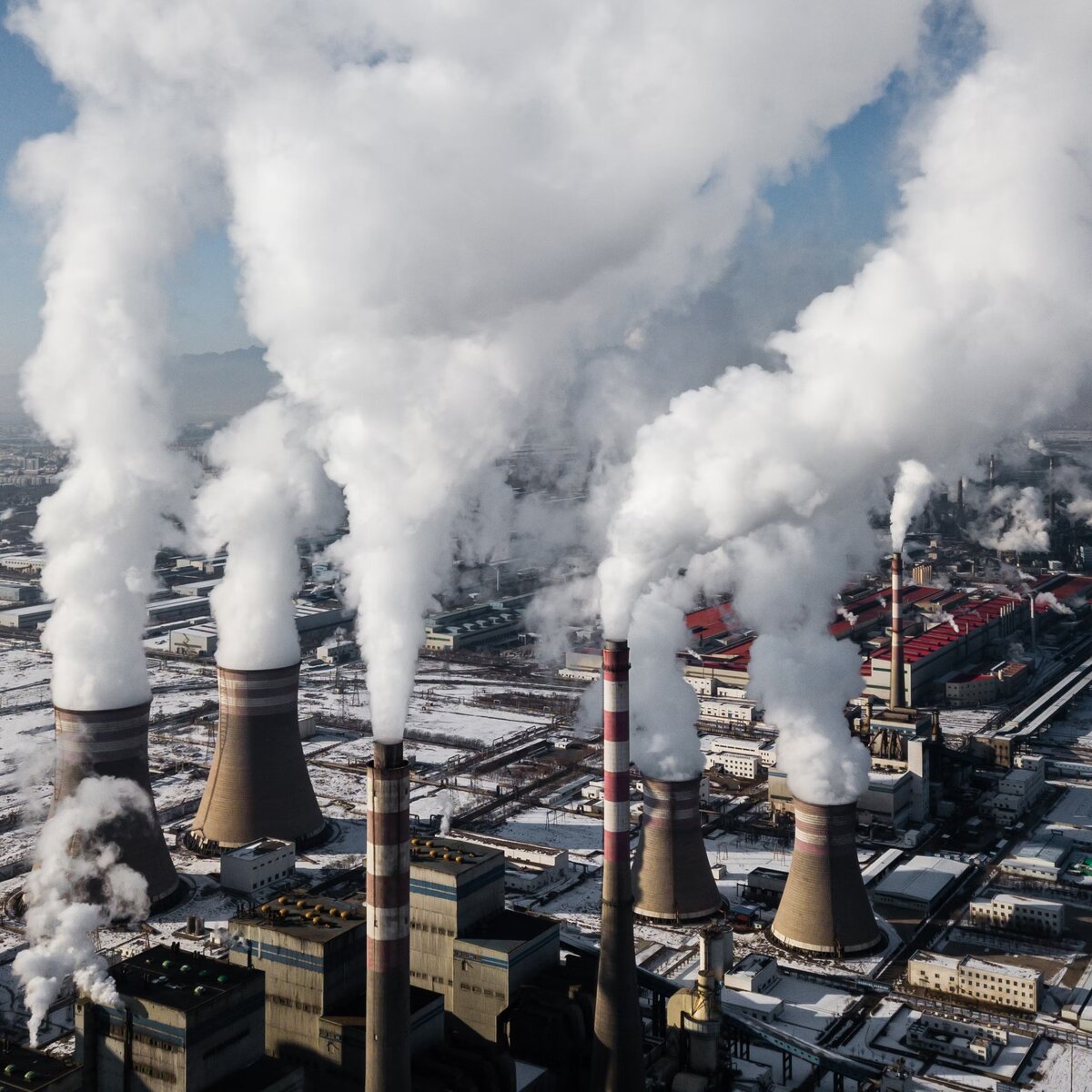Home>Gardening News and Trends>Why Is Greenhouse Gas Emissions Bad


Gardening News and Trends
Why Is Greenhouse Gas Emissions Bad
Modified: January 22, 2024
Stay updated with the latest news on why greenhouse gas emissions are bad and their impact on the environment.
(Many of the links in this article redirect to a specific reviewed product. Your purchase of these products through affiliate links helps to generate commission for Chicagolandgardening.com, at no extra cost. Learn more)
Table of Contents
- Introduction
- Definition of Greenhouse Gases
- Causes of Greenhouse Gas Emissions
- Environmental Impacts of Greenhouse Gas Emissions
- Climate Change and Global Warming
- Health Effects of Greenhouse Gas Emissions
- Impact on Biodiversity
- Economic Consequences of Greenhouse Gas Emissions
- Strategies to Reduce Greenhouse Gas Emissions
- Conclusion
Introduction
Greenhouse gas emissions have become one of the most pressing issues facing our planet today. The term “greenhouse gases” refers to gases in the Earth’s atmosphere that trap heat and contribute to global warming. These gases include carbon dioxide (CO2), methane (CH4), nitrous oxide (N2O), and fluorinated gases.
Over the past century, human activities, such as burning fossil fuels, deforestation, and industrial processes, have significantly increased the concentration of greenhouse gases in the atmosphere. This has led to a phenomenon known as the greenhouse effect, where these gases trap heat close to the Earth’s surface, causing the planet to warm.
The consequences of greenhouse gas emissions are far-reaching and impact multiple aspects of our environment. From climate change and global warming to health effects and economic consequences, the negative impacts of greenhouse gas emissions are felt on a global scale.
This article aims to explore and shed light on the various environmental, health, biodiversity, and economic impacts of greenhouse gas emissions. Additionally, it will discuss strategies and initiatives to reduce these emissions in order to mitigate the negative effects.
It is crucial to understand the detrimental effects of greenhouse gas emissions in order to create awareness and foster collective action towards a more sustainable and greener future.
Definition of Greenhouse Gases
Greenhouse gases (GHGs) are gases in the Earth’s atmosphere that have the ability to trap heat from the sun and contribute to the greenhouse effect. These gases play a critical role in regulating the Earth’s climate by preventing some of the heat from escaping back into space.
The most common greenhouse gases include carbon dioxide (CO2), methane (CH4), nitrous oxide (N2O), and fluorinated gases. CO2 is the primary greenhouse gas responsible for the majority of human-induced global warming. It is mainly released through the burning of fossil fuels such as coal, oil, and natural gas.
Methane is another potent greenhouse gas, which is released during the production and transport of coal, oil, and natural gas. It is also emitted by livestock and other agricultural practices, as well as the decay of organic waste in landfills.
Nitrous oxide is primarily emitted from agricultural and industrial activities, as well as the combustion of fossil fuels and solid waste. Fluorinated gases, such as hydrofluorocarbons (HFCs), are synthetic compounds mainly used in industrial processes, refrigeration, and air conditioning systems.
These greenhouse gases accumulate in the Earth’s atmosphere, forming a “blanket” that traps heat and warms the planet. Without this natural greenhouse effect, the Earth’s average temperature would be significantly cooler, making it inhospitable for life as we know it.
It is important to note that while greenhouse gases are necessary for maintaining the Earth’s temperature within a habitable range, excessive emissions of these gases through human activities have disrupted the delicate balance of the Earth’s climate system. This has resulted in global warming and the associated impacts on the environment and human well-being.
Understanding the different types of greenhouse gases and their sources is crucial in addressing the issue of climate change and formulating effective strategies to reduce greenhouse gas emissions.
Causes of Greenhouse Gas Emissions
The increase in greenhouse gas emissions can be attributed to various human activities that release these gases into the atmosphere. The primary causes of greenhouse gas emissions include:
- Burning of Fossil Fuels: The combustion of fossil fuels, such as coal, oil, and natural gas, for electricity generation, transportation, and industrial processes is a major source of greenhouse gas emissions. The release of carbon dioxide (CO2) from these activities contributes significantly to global warming.
- Deforestation and Land Use Changes: When forests are cleared for agriculture, urbanization, or logging purposes, the carbon stored in trees is released into the atmosphere as carbon dioxide (CO2). Furthermore, the loss of forests reduces the Earth’s capacity to absorb CO2 emissions, exacerbating the greenhouse effect.
- Agricultural Practices: Certain agricultural practices, such as livestock production and rice cultivation, emit significant amounts of methane (CH4), a potent greenhouse gas. Livestock, particularly cattle, produce methane during digestion, while flooded rice paddies create an anaerobic environment conducive to methane production.
- Industrial Processes: Industrial activities, including manufacturing, chemical production, and cement production, release greenhouse gases such as carbon dioxide (CO2), methane (CH4), and nitrous oxide (N2O) as byproducts. These gases are emitted through the burning of fossil fuels, chemical reactions, and waste management.
- Waste Management: Improper waste management, specifically the decomposition of organic waste in landfills, leads to the release of methane (CH4). Methane is produced during the anaerobic breakdown of organic matter, such as food waste and yard trimmings.
These human activities significantly contribute to the rise in greenhouse gas emissions, leading to global warming and climate change. It is essential to address these causes and adopt sustainable practices to reduce greenhouse gas emissions and mitigate their impacts.
Environmental Impacts of Greenhouse Gas Emissions
The increase in greenhouse gas emissions has profound and wide-ranging environmental impacts. These impacts affect ecosystems, weather patterns, natural resources, and the overall health of the planet. The key environmental consequences of greenhouse gas emissions include:
- Climate Change: One of the most significant impacts of greenhouse gas emissions is climate change. The Earth’s average temperature has been steadily rising due to the greenhouse effect, resulting in changes in weather patterns, rising sea levels, and more frequent and severe extreme weather events such as hurricanes, droughts, and heatwaves.
- Disruption of Ecosystems: The changing climate caused by greenhouse gas emissions disrupts ecosystems worldwide. Many species are struggling to adapt to rapid temperature changes, leading to shifts in habitats and loss of biodiversity. For example, coral reefs, which are highly sensitive to temperature changes, are experiencing bleaching events and widespread die-offs due to increased ocean temperatures.
- Loss of Natural Resources: Greenhouse gas emissions impact the availability and quality of natural resources. Rising temperatures and altered precipitation patterns affect water resources, leading to droughts in some regions and increased flooding in others. Changes in temperature and rainfall can also impact agricultural productivity, threatening food security.
- Melting Ice Caps and Glaciers: Higher temperatures caused by greenhouse gas emissions are causing the accelerated melting of ice caps and glaciers. This leads to rising sea levels, which pose a significant threat to coastal communities and habitats. It also affects the availability of freshwater resources, as many regions rely on glacial meltwater for their water supply.
- Ocean Acidification: Increased carbon dioxide (CO2) levels in the atmosphere are causing the oceans to become more acidic through a process known as ocean acidification. This has detrimental effects on marine life, particularly coral reefs, shellfish, and other organisms that rely on calcium carbonate structures.
- Loss of Carbon Sinks: Forests and other vegetation play a vital role in absorbing carbon dioxide (CO2) from the atmosphere, acting as carbon sinks. However, deforestation and land use changes caused by human activities release stored carbon back into the atmosphere, reducing the effectiveness of these natural carbon sinks.
It is essential to address the environmental impacts of greenhouse gas emissions through sustainable practices, conservation efforts, and the reduction of emissions to preserve the Earth’s ecosystems and protect the planet for future generations.
Climate Change and Global Warming
Greenhouse gas emissions have led to a phenomenon known as global warming, which is causing significant changes in the Earth’s climate. Global warming refers to the long-term increase in average temperatures on a global scale.
As greenhouse gases accumulate in the atmosphere, they trap heat close to the Earth’s surface, resulting in a rise in temperature. This increased temperature disrupts the balance of natural climatic patterns, leading to climate change.
The consequences of climate change are wide-ranging and impactful. Here are some key aspects affected by climate change:
- Rising Temperatures: The Earth’s average surface temperature has risen by about 1 degree Celsius (1.8 degrees Fahrenheit) since the late 19th century. This increase in temperature contributes to the melting of ice caps, rising sea levels, and more frequent and intense heatwaves.
- Changing Weather Patterns: Climate change affects weather patterns, making them more unpredictable and extreme. We are witnessing an increase in the frequency and intensity of hurricanes, droughts, floods, and other extreme weather events.
- Sea-Level Rise: Global warming causes the melting of glaciers, ice caps, and polar ice sheets. This leads to an increase in the volume of water in the Earth’s oceans, resulting in rising sea levels. This poses a significant threat to coastal communities, low-lying islands, and critical coastal ecosystems.
- Impacts on Agriculture: Changes in temperature and precipitation patterns affect agricultural productivity and food security. Rising temperatures, droughts, and floods can damage crops, reduce yields, and disrupt the availability and accessibility of food resources.
- Displacement of Species and Loss of Biodiversity: As temperatures rise and ecosystems change, many species are facing challenges in adapting or migrating to more suitable habitats. This can lead to the displacement and extinction of species, disrupting ecosystems and reducing biodiversity.
- Health Risks: Climate change impacts human health through increased heat-related illnesses, the spread of infectious diseases, reduced air quality, and the disruption of food and water resources. Vulnerable populations, such as the elderly, children, and those with underlying health conditions, are particularly at risk.
To mitigate the impacts of climate change and global warming, it is crucial to reduce greenhouse gas emissions, transition to renewable energy sources, promote sustainable land use practices, and adapt to the changing climate. Collective action and international cooperation are essential in combating this global challenge and ensuring a sustainable future for generations to come.
Health Effects of Greenhouse Gas Emissions
The increase in greenhouse gas emissions has far-reaching implications for human health, with various direct and indirect impacts. These emissions contribute to climate change, air pollution, and other environmental changes that pose significant health risks. Here are some of the key health effects of greenhouse gas emissions:
- Air Pollution and Respiratory Issues: Greenhouse gas emissions, particularly the release of pollutants from burning fossil fuels, contribute to poor air quality. This can lead to respiratory issues such as asthma, bronchitis, and other chronic obstructive pulmonary diseases (COPD).
- Heat-Related Illnesses: Global warming caused by greenhouse gas emissions increases the frequency and intensity of heatwaves. Exposure to high temperatures can result in heatstroke, dehydration, and other heat-related illnesses, particularly among vulnerable populations such as the elderly and young children.
- Allergies and Infectious Diseases: Changes in climate and weather patterns due to greenhouse gas emissions can affect the prevalence and distribution of allergens and disease vectors. This leads to an increased risk of allergies, as well as the spread of infectious diseases such as malaria, dengue fever, and Lyme disease.
- Water and Foodborne Illnesses: Climate change and associated changes in precipitation patterns can impact water quality, leading to waterborne diseases. Additionally, disruptions in food production and distribution can result in foodborne illnesses, malnutrition, and an increased risk of foodborne illnesses.
- Mental Health Issues: Climate change and its associated impacts, such as natural disasters and displacement, can have severe psychological effects. Increased stress, anxiety, depression, and post-traumatic stress disorder (PTSD) are prevalent among individuals affected by climate-related events.
- Impacts on Vulnerable Populations: The health effects of greenhouse gas emissions disproportionately affect vulnerable populations, including the elderly, children, pregnant women, low-income communities, and those with pre-existing health conditions. These groups often lack access to adequate healthcare and may face greater challenges in adapting to the changing climate.
Addressing the health impacts of greenhouse gas emissions requires a comprehensive approach, including reducing emissions, improving air quality, enhancing healthcare accessibility, and implementing climate change adaptation strategies. By prioritizing the health of individuals and communities, we can work towards a more sustainable future and ensure the well-being of present and future generations.
Impact on Biodiversity
The increasing levels of greenhouse gas emissions have significant implications for biodiversity, leading to a range of negative impacts on ecosystems and the various species that inhabit them. The key ways in which greenhouse gas emissions affect biodiversity are as follows:
- Habitat Loss and Fragmentation: Climate change, driven by greenhouse gas emissions, disrupts ecosystems and alters the availability of suitable habitats for many species. Rising temperatures, changing rainfall patterns, and shifts in vegetation can lead to habitat loss and fragmentation. This can result in the displacement and extinction of vulnerable species.
- Shifts in Species Distribution: Changes in temperature and weather patterns caused by greenhouse gas emissions can cause shifts in the geographical range of many plant and animal species. Some species may struggle to adapt or migrate quickly enough to keep pace with changing conditions, leading to imbalances and potential extinctions.
- Loss of Keystone Species: Keystone species, which play a critical role in maintaining the balance of their ecosystems, are particularly vulnerable to the impacts of climate change. The loss of these key species can have cascading effects on the entire ecosystem, leading to disruptions in food chains and ecosystem functions.
- Coral Bleaching and Marine Life: Increased ocean temperatures caused by greenhouse gas emissions contribute to coral bleaching events. Corals are highly sensitive to temperature changes, and prolonged exposure to warmer waters causes them to expel the algae that provide them with nutrients and color. This leads to widespread coral die-offs, negatively impacting marine biodiversity.
- Loss of Genetic Diversity: Climate change resulting from greenhouse gas emissions can reduce the genetic diversity within populations. Limited genetic variability makes species more susceptible to disease, reduces their ability to adapt to changing conditions, and can hinder their long-term survival.
- Disruption of Ecosystem Services: Biodiversity loss due to climate change can disrupt essential ecosystem services that support human well-being. These services include pollination, nutrient cycling, water purification, and carbon sequestration. Their decline can have cascading effects on agriculture, clean water availability, and climate regulation.
Protecting biodiversity and mitigating the impacts of greenhouse gas emissions are essential for preserving ecosystems and the services they provide. Conservation efforts, habitat restoration, sustainable land-use practices, and international cooperation are crucial in safeguarding biodiversity and the delicate balance of our planet’s diverse ecosystems.
Economic Consequences of Greenhouse Gas Emissions
The increasing levels of greenhouse gas emissions have significant economic consequences, impacting various sectors and industries around the world. The economic implications of these emissions can be seen in several ways:
- Cost of Climate-Related Disasters: Climate change, driven by greenhouse gas emissions, has led to an increase in the frequency and intensity of climate-related disasters such as hurricanes, droughts, and floods. These disasters result in significant economic losses, including damage to infrastructure, agriculture, and property.
- Reduced Agricultural Productivity: Climate change affects agricultural productivity, leading to crop failures, reduced yields, and increased vulnerability of farming communities. This can result in food shortages, higher food prices, and increased economic instability in regions dependent on agriculture.
- Healthcare Costs: The health impacts of greenhouse gas emissions, such as increased air pollution and heat-related illnesses, impose substantial healthcare costs. Treating respiratory diseases, heatstroke, and other climate-related health issues strains healthcare systems and increases expenditures.
- Infrastructure Costs: Rising sea levels and extreme weather events associated with climate change require significant investments in infrastructure adaptation and resilience. Protecting coastal areas, upgrading water and sanitation systems, and reinforcing buildings and transportation networks involve substantial economic costs.
- Energy Transition: Transitioning from fossil fuels to renewable energy sources to reduce greenhouse gas emissions requires substantial investments in alternative energy technologies and infrastructure. While there may be upfront costs, the long-term economic benefits include job creation, energy savings, and improved energy security.
- Impact on Tourism and Recreation: Climate change can negatively impact tourism and recreational activities, particularly in regions dependent on natural attractions. Rising temperatures, shifts in weather patterns, and the degradation of ecosystems can deter tourists and impact local economies that rely on tourism revenue.
It is crucial to recognize that taking action to reduce greenhouse gas emissions and mitigate climate change can also have positive economic impacts. The development of renewable energy industries, the creation of green jobs, and the promotion of sustainable practices can foster economic growth, innovation, and resilience in the long run. Transitioning to a low-carbon economy can unlock new opportunities and promote sustainable development.
Strategies to Reduce Greenhouse Gas Emissions
Reducing greenhouse gas emissions and mitigating the impacts of climate change require collective action and the implementation of effective strategies at various levels. Here are some key strategies that can help reduce greenhouse gas emissions:
- Transition to Renewable Energy: Shifting from fossil fuels to renewable energy sources such as solar, wind, and hydroelectric power is crucial in reducing greenhouse gas emissions. Investing in renewable energy infrastructure and promoting the adoption of clean technologies can significantly contribute to decarbonizing the energy sector.
- Improve Energy Efficiency: Increasing energy efficiency in buildings, industries, and transportation helps reduce greenhouse gas emissions. This can be achieved through energy-efficient appliances, better insulation, energy management systems, and the promotion of public transportation, cycling, and walking as sustainable transportation options.
- Sustainable Land Use Practices: Protecting forests, implementing sustainable agriculture techniques, and restoring degraded land are essential in reducing greenhouse gas emissions. These practices not only help sequester carbon dioxide (CO2) but also promote biodiversity, enhance ecosystem services, and support sustainable livelihoods.
- Reduce Waste and Promote Recycling: Implementing waste management strategies that reduce emissions from landfills is crucial. This includes promoting recycling, composting, and incentivizing the adoption of circular economy principles to minimize waste generation and maximize resource efficiency.
- Transition to Low-Carbon Transportation: Encouraging the use of electric vehicles (EVs), improving public transportation systems, and investing in clean and efficient alternatives are critical steps in reducing greenhouse gas emissions from transportation. Additionally, promoting active transportation modes such as walking and cycling can further reduce emissions.
- International Cooperation and Policy Frameworks: Collaborating internationally to establish and implement policies, agreements, and frameworks that address greenhouse gas emissions is paramount. This includes commitments such as the Paris Agreement, which aims to limit global temperature rise and promote adaptation and mitigation efforts.
- Educate and Raise Awareness: Education and awareness play a significant role in encouraging individual action and collective responsibility. Promoting sustainable lifestyles, providing information on the impacts of greenhouse gas emissions, and fostering a culture of environmental consciousness can inspire behavioral change and support sustainability efforts.
Implementing these strategies requires commitment and engagement from governments, businesses, communities, and individuals. By working together and adopting sustainable practices, we can reduce greenhouse gas emissions, mitigate climate change, and ensure a more sustainable and resilient future for generations to come.
Conclusion
Greenhouse gas emissions pose a significant threat to our planet and its inhabitants. The relentless release of these gases into the Earth’s atmosphere through human activities has resulted in far-reaching environmental, health, and economic consequences.
From climate change and global warming to the loss of biodiversity and the increased prevalence of health issues, the impacts of greenhouse gas emissions are pervasive and require urgent action. The need to reduce these emissions and transition to a low-carbon, sustainable future is paramount.
By implementing strategies such as transitioning to renewable energy sources, improving energy efficiency, adopting sustainable land-use practices, reducing waste, promoting low-carbon transportation, and fostering international cooperation, we can significantly reduce greenhouse gas emissions and mitigate their consequences.
Education and awareness play a crucial role in inspiring individuals, communities, businesses, and governments to take action. By understanding the detrimental effects of greenhouse gas emissions, we can make informed choices and collectively work towards a more sustainable and resilient future.
It is essential that we recognize the interconnectedness of environmental, social, and economic systems and strive for solutions that address multiple aspects of sustainability. Through collaboration, innovation, and a shared commitment to preserving our planet, we can overcome the challenges posed by greenhouse gas emissions and create a healthier and more sustainable world for generations to come.







